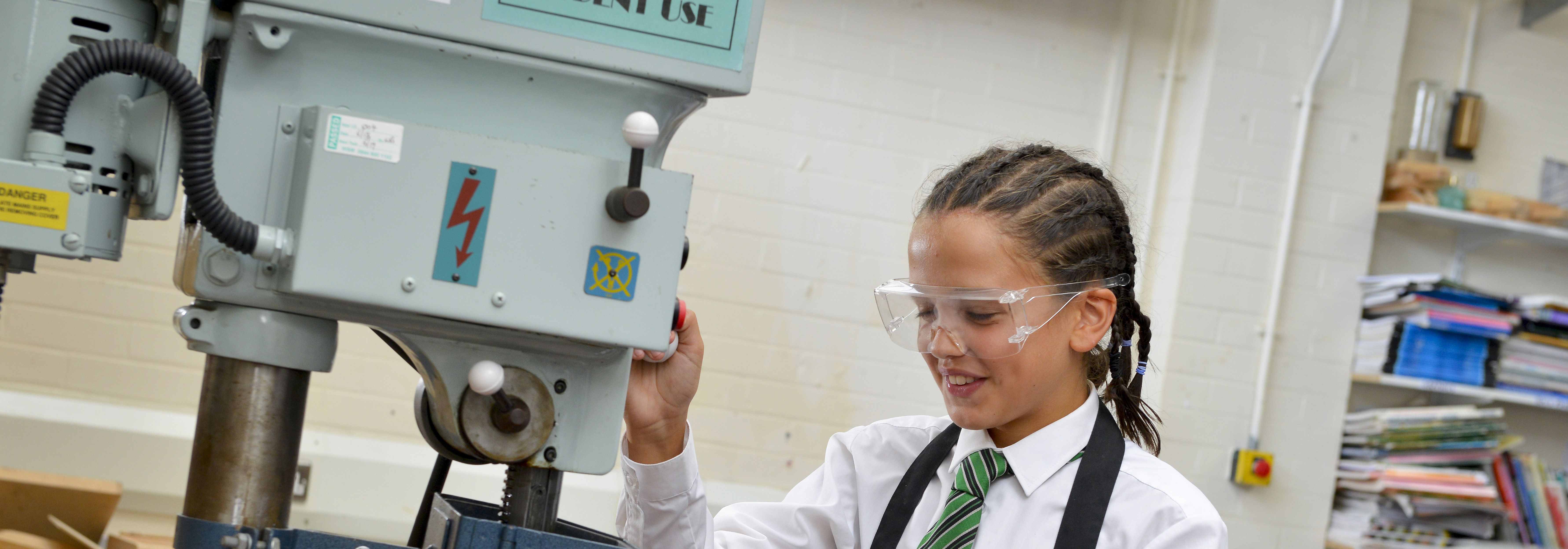The Knowledge and Skills overviews show the specific chemistry content students will learn in each unit of study throughout the year. These documents outline both the substantive knowledge (atomic structure, chemical bonding, and reaction types) and the disciplinary skills (laboratory techniques, quantitative analysis, and scientific methodology) that students will develop. Each unit is broken down to clearly identify what students need to know and what they should be able to do upon completion. Through the systematic development of both knowledge and skills, students build chemical literacy, experimental precision, and conceptual understanding of matter and its transformations appropriate to their stage of learning.
Select a unit to find out more...
Particles
| Unit Progress Criteria |
| Knowledge |
Skills |
|
States of Matter
- All matter is made of particles
- The three states of matter are solid, liquid and gas
- Solids, liquids, and gases have different properties
- Solids have a fixed shape, cannot flow, and cannot be compressed.
- Liquids can flow, take the shape of their container, and cannot be compressed
- Gases can flow, completely fill their container, and can be compressed
The Particle Model
- The three states of matter can be represented by a simple model, in which the particles are represented by small solid spheres
- The particles in a solid are close together, vibrate on the spot and are arranged in a regular pattern. They have the least energy.
- The particles in a liquid are close together, move freely and are arranged in a random way.
- The particles in a gas are far apart, move freely and are arranged in a random way. There is nothing in the space between particles. They have the most energy.
- Solids, liquids, and gases have distinct physical properties due to the arrangement of the particles
- The particles in a solid can vibrate in a fixed position and cannot move from place to place because there are strong forces which attract the particles towards each other.
- The particles in a liquid can move around each other because the forces are strong enough to keep the particles close together, but weak enough to let them move around each other
- The particles in a gas are free to move in any direction because there are weak forces between the particles
- When a solid is heated the particles vibrate more, causing the distance between the particles to increase and the object to expand
Changing State
- Particle theory can help to explain melting, boiling, freezing, and condensing
- Melting and freezing take place at the melting point
- Melting is the change of state from a solid to a liquid. A substance changes from a solid to a liquid at the melting point
- Freezing is the change of state from a liquid to a solid. A substance changes from a liquid to a solid at the freezing point
- Boiling and condensing take place at the boiling point.
- Boiling is the change of state from a liquid to a gas. A substance changes from a liquid to gas at the boiling point
- Boiling occurs in a liquid when particles have sufficient energy to overcome the forces between them and move apart randomly
- Evaporation happens at the surface of a liquid as it boils. Evaporation can occur over a large range of temperatures
- Condensation is the change of state from a gas to a liquid. A substance changes from a gas to a liquid at the condensing point
Diffusion
- Diffusion is the movement of particles from a high concentration to a lower concentration.
- Diffusion cannot happen in solids because particles in a solid are not free to move
- Diffusion happens faster when the particles in a gas or liquid gain energy and are moving faster after heating
- Variables are factors that change in an investigation
- An independent variable is one that the scientist changes
- The dependent variable is one that is measured
- Control variables are those that are kept the same, to ensure that the dependent variable is only influenced by the independent variable
Gas Pressure
- Gas pressure occurs because of particles colliding with the walls of a container
- More collisions result in greater pressure
- Less collisions result in less pressure
- Pressure in liquids increases with depth
- Atmospheric pressure decreases with increasing height as the weight of air above decreases with height.
Density
- Density is the amount of matter in a given volume
- Objects float in water if they are less dense than water and they sink if they are more dense
|
Disciplinary knowledge
- Use models to represent data, events, processes, behaviours and other scientific phenomena
Assess risk, to include:
- Identify hazard symbols
- Describe sensible precautions to reduce risk
- Identify names and uses of basic lab equipment and apparatus
Identify in a given context:
- the independent variable as the one that is changed or selected by the investigator
- the dependent variable that is measured for each change in the independent variable
- Identify suitable control variables and be able to explain why they are kept the same.
- Suggest a hypothesis to explain given observations or data.
- Explain why a certain hypothesis was chosen, with reference to scientific theories and explanations
- Substitute numerical values into algebraic equations using appropriate units for physical quantities
- Solve simple algebraic equations Determine densities of solid and liquid objects
- Calculate areas of triangles and rectangles, surface areas and volumes of cubes
Practical skills
- Measure volumes of liquids accurately
- Safe use of heating devices and techniques, including Bunsen burner, electric heater and water bath
|
Atoms, Elements and Compounds
| Unit Progress Criteria |
| Knowledge |
Skills |
|
Atoms and Elements
- Elements are made from only one type of atom
- The atoms in an element are the same, but the atoms in different elements are different
- Different elements have different properties because of the different atoms they are composed of
- There are about 100 different elements
- All substances are composed of atoms
- An atom is the smallest part of an element that can exist
- Elements are shown in the Periodic table
- Elements have specific physical and chemical properties
The Periodic Table
- Atoms of each element are represented by a unique chemical symbol
- The first letter of the chemical symbol is always a capital (uppercase) letter
- If a chemical symbol has two letters, the second letter is always lowercase
- Vertical columns in the periodic table are referred to as groups.
- Elements in the same group have similar chemical properties
- Rows in the periodic table are referred to as periods
Metals and Non-Metals
- Metals are generally shiny, sonorous, ductile, with high density, high melting and boiling points. They have many uses relating to these properties
- Sonorous metals make a ringing sound when struck
- Ductile means that they can be drawn out (or stretched) to make thin wires
- Some (but not all) metals are magnetic
- Non-metals are generally brittle, dull and non-sonorous. They have low density, low melting and boiling points and are poor conductors of heat and electricity
- Brittle means hard but breaks easily
- Metals are arranged in the reactivity series
- The most reactive metals are found at the top of the reactivity series
Compounds and Molecules
- A compound has different properties from the elements from which it’s made
- Compounds are formed from elements by chemical reactions
- A compound is a substance composed of two or more elements chemically bonded together
- A molecule is a small group of non-metal atoms chemically joined together
- A compound contains two or more elements chemically joined together in fixed proportions
- The small subscript number after an element symbol represents the number of atoms of that element in one molecule
- A chemical change can be indicated if there is a change in temperature, colour, smell, or if bubbles are produced
- Bubbles indicate that a gas is produced
Hazards in the Lab
- Hazard symbols are used on chemical and containers so that appropriate safety precautions can be taken
- A precaution is something you do to reduce the risk to yours and others health
- Corrosive materials will damage body tissue and materials and can cause serious injury
- Flammable substances can set on fire easily and should be kept away from heat sources
- Toxic substances are poisonous to us (and likely other animals) and can have life threatening effects. They should not be ingested or inhaled, or come in contact with the skin or eyes
- Harmful substances may irritate the skin or cause other damage to body tissues. This can be minor, or it may cause long lasting health effects
- They should be kept away from the skin and eyes and should not be ingested or inhaled
- Environmentally hazardous means that the substance is toxic to aquatic organisms or can have long lasting environmental effects. These substances should be disposed of carefully
- Explosive substances may explode as a result of fire, heat, shock or friction. They should be stored and handled carefully
|
Disciplinary knowledge
Find the arithmetic mean and range of a set of data
- Recognise and use expressions in decimal form
Draw conclusions from given observations.
- Draw conclusions from a graph
- Draw conclusions from a table
Describe a practical procedure for a specified purpose
- Include a coherent and sensible order of steps, with sufficient detail to obtain valid results, including suggested equipment
Practical Skills
Measurement of rates of reaction by a variety of methods including production of gas, uptake of water and colour change of indicator
|
Mixtures
| Unit Progress Criteria |
| Knowledge |
Skills |
|
Pure Substances and Mixtures
- A mixture consists of two or more types of atoms or compounds not chemically combined together
- A pure substance is made of one type of atom or compound
- Pure substances melt and boil at specific temperatures
- Melting points and boiling points can be used to identify pure substances or mixtures
- A suspension is a mixture of at least one insoluble solid and a liquid
Solutions
- A solution is composed of a solute and a solvent
- A solvent is the substance that a solute dissolves in
- A solute is the substance that dissolves in a solvent
- A saturated solution is a solution in which no more solute will dissolve
- An unsaturated solution is a solution in which solute will dissolve
- A substance is soluble if it will dissolve to form a solution
- A substance is insoluble if it will not dissolve to form a solution
- A solute dissolves when the solute particles fill in the spaces between the solvent particles
- Dissolving is a process where solute particles disperse throughout the solvent
Separation Techniques
- Mixtures can be separated by physical processes such as filtration, crystallisation, simple distillation, fractional distillation and chromatography
- These physical processes do not involve chemical reactions and no new substances are made
- Decanting separates large insoluble solids from liquids
- Evaporation separates dissolved solids from their solvent
- A disadvantage of evaporation is that liquid is lost to the atmosphere
- In distillation, a solution can be separated by evaporating the solvent
- Distillation separates a solvent from a solution by using evaporation and condensation
- The substance collected at the end of the distillation process is called the distillate
- During distillation, a condenser cools the hot vapour, causing it to condense into a liquid
- During distillation, a thermometer measures the temperature of the vapour
- In crystallisation, the liquid is evaporated to leave behind solid crystals
- Filtration separates a solid from a liquid
- The pure liquid collected is called the filtrate
- Fractional distillation is a method used to separate a liquid mixture
- Each part of the mixture to be separated is called a fraction
- The different fractions in a mixture can be separated due to their different boiling points
- Chromatography is a separation technique used to separate mixtures, especially coloured pigments and dyes
- Chromatography separates soluble substances that travel at different speeds through a stationary phase
- Rf = distance moved by substance / distance moved by solvent
- Rf values are used to identify a substance in a particular solvent
- A large Rf value indicates the substance is very soluble in the solvent, and it travels higher up the stationary phase
- A small Rf value indicates the substance is less soluble in the solvent, and it travels less high up the stationary phase
|
Disciplinary knowledge:
Describe, suggest or select the technique, instrument, apparatus or material that should be used for a particular purpose, and explain why
Select the best procedure from given options
- Explain why a given practical procedure is well designed for its specified purpose
- Apply understanding of apparatus and techniques to suggest a procedure for a specified purpose
Assess risk, to include:
- Identify hazard symbols
- Describe sensible precautions to reduce risk
Identify names and uses of basic lab equipment and apparatus
Practical skills:
- Measure volumes of liquids accurately
- Measure temperature accurately
- Safe use of equipment to separate mixtures using evaporation
- Safe use of equipment to separate mixtures using filtration
- Safe use of equipment to separate mixtures using crystallisation
- Safe use of equipment to separate mixtures using chromatography
- Safe use of equipment to separate mixtures using distillation
- Plot two variables from experimental or other data
- Produce clear, labelled scientific drawings
- Safe use of heating devices and techniques, including Bunsen burner, electric heater and water bath
|
Acids and Alkalis
| Unit Progress Criteria |
| Knowledge |
Skills |
|
Acids and Alkalis
- Substances can be classified into acidic, alkaline and neutral solutions
- The pH scale, from 0 to 14, is a measure of the acidity or alkalinity of a solution
- Acids and alkalis can be strong or weak
- Weak acids have a sour taste. These are not harmful to touch
- The pH scale can be measured using litmus (paper or solution), universal indicator (paper or solution) or a pH probe.
- A solution with pH 7 is neutral
- Aqueous solutions of acids have pH values of less than 7
- Aqueous solutions of alkalis have pH values greater than 7
- Aqueous solutions of alkalis have pH values greater than 7
- Between pH 8 and pH 14, the lower the pH the weaker the alkali
- Between pH 0 and pH 6, the higher the pH the weaker the acid
- Between pH 0 and pH 6, the lower the pH the stronger the acid
- Each number on the pH scale is 10x greater than the previous number, for example a pH of 11 is 10x more alkaline than a pH of 10
- Strong acids and alkalis are corrosive
- Corrosive means they can cause irreversible damage when touched
- The formula for hydrochloric acid is HCl
- The formula for nitric acid is HNO3
- The formula for sulphuric acid is H2SO4
- The formula for sodium hydroxide is NaOH
Indicators
- Litmus indicator is red in an acidic solution
- Litmus indicator is blue in an alkaline solution
- Litmus indicator remains the same colour in a neutral solution
- Universal indicator colour ranges from red to yellow in an acidic solution
- Universal indicator colour ranges from blue to purple in an alkaline solution
- Universal indicator is green in a neutral solution
Word Equations
- Chemical reactions can be represented with word equations
- Word equations show reactants on the left-hand side, and products on the right-hand side
- Word equations always have at least one reactant and at least one product
- A reactant is a substance that is present at the start of a reaction
- Reactants will react with each other to make a new substance (or substances) called a product
- In between the reactants and products in a word equation, an arrow indicates that a chemical change occurs
- In general word equations take the form: reactant (+ reactant) à product (+ product)
Reactions of Acids and Alkalis
- In neutralisation reactions an acid reacts with an alkali to form a salt and water.
- Neutralisation can be represented by the general equation: Acid + Alkali salt + water
- Neutralisation forms a neutral (pH7) solution
- A salt is a metal compound made from acid
- A salt is formed when the hydrogen in an acid is replaced by a metal
- Hydrochloric acid produces chloride salts
- Nitric acid produces nitrate salts
- Sulphuric acid produces sulphate salts
- A metal carbonate is a compound containing a metal, carbon and oxygen
- Metal carbonates react with acids to form a salt, water and carbon dioxide
- The reaction of acids and metal carbonates can be represented by the word equation: metal carbonate + acid -> salt + water + carbon dioxide
|
Disciplinary Knowledge
Assess risk, to include:
- Identify hazard symbols
- Describe sensible precautions to reduce risk
- Describe a practical procedure for a specified purpose
- Include a coherent and sensible order of steps, with sufficient detail to obtain valid results, including suggested equipment
Practical Skills
- Measure volumes of liquids accurately
- Measure pH
- Preparation of a pure dry sample of a soluble salt
- Measure mass accurately
|












